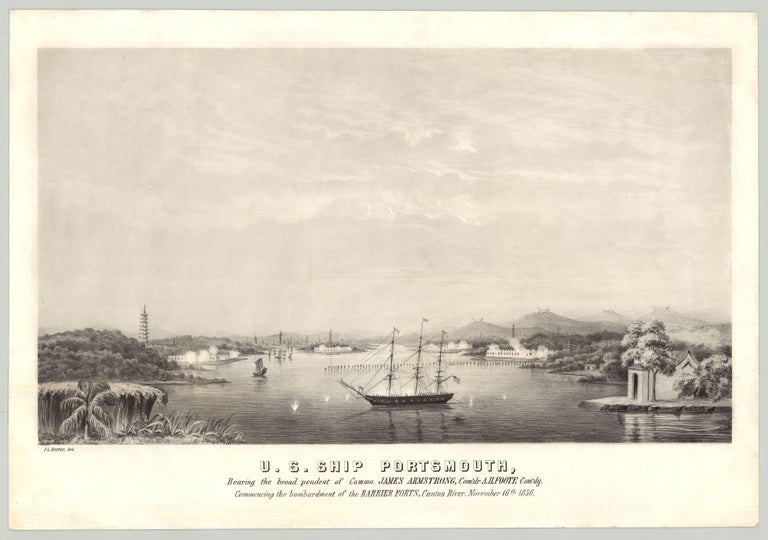U. S. Ship Portsmouth, Bearing the broad pendent of Commo. James Armstrong, Com’dr. A. H. Foote, Com’dg. Commencing the bombardment of the Barrier Forts, Canton River, Nov. 16th, 1856.
[Philadelphia?: P. S. Duval?, lithographer, c. 1856]. Lithograph, 12” x 21” plus margins. CONDITION: Good, discreetly repaired tear seven inches into image at lower left, two repaired tears in margin, margins lightly soiled. An exceptionally rare lithograph depicting The Battle of the Pearl River Forts, also known as the Battle of the Barrier Forts, in late 1856, at the beginning of the Second Opium War. The USS Portsmouth is shown in the center of the river exchanging fire with four forts visible at the water’s edge. The Battle of the Pearl River Forts, consisted of a series of brief military engagements, punctuated by failed attempts at diplomacy, between American and Chinese forces shortly after the outbreak of the Second Opium War. The Portsmouth, along with two other passing vessels, were initially charged with protecting American lives and property from the threat caused by the War. Violent conflict arose as American forces were withdrawing their land presence in Canton in favor of amphibious assaults against the four Barrier Forts along the river. In the action depicted in this print, the Americans were apparently galvanized to defend—or revenge—themselves after Commander Foote of the Portsmouth was fired upon as he rowed back to his ship. On 16 November the American squadron, consisting of the Portsmouth, the USS Levant, and the crew of USS San Jacinto (the vessel itself drew too much water to participate), bombarded the forts for two hours before they fell silent. An attempt was made to resolve the conflict through diplomacy, but the effort failed and the battle resumed. Commander Foote then led a land assault, capturing one of the forts and soon reducing another with its guns. Within a few days all of the forts were in American control. In his official report, Foote noted 250 Chinese wounded or killed, and on the American side seven killed and twenty-two wounded. The Portsmouth was struck some eighteen times during the battle, but sustained no significant damage. U.S. trade with China at this time was on a much smaller scale than that of Britain or other European nations, and after all four river forts were captured, America signed a treaty with China and remained largely neutral in the rest of the Second Opium War. However, the trade advantages gained by British and French efforts won these privileges for the U.S. as well. There is no publication credit on this print, but the image is credited on the lower left to artist J. L. Keffer, who, according to Groce & Wallace, worked for P. S. Duval, a leading Philadelphia lithographer. OCLC records a single copy at the American Antiquarian Society; Google uncovers another copy at the U. S. Naval Academy Museum. REFERENCES: Stein, American Naval Prints #41 (the U.S. Naval Academy copy, pictured); Tucker, Spencer. Almanac of American Military History, (Santa Barbara, 2013), pp. 781–2; Groce, George C. and David H. Wallace. The New-York Historical Society’s Dictionary of Artists in America 1564-1860, p. 362.
Item #3407
Price: $3,750.00


